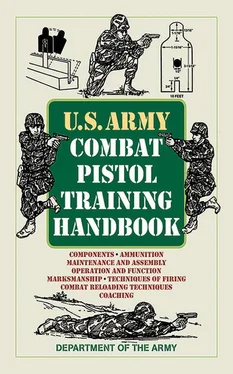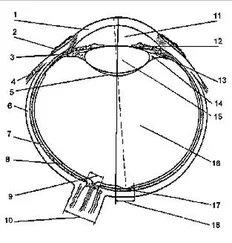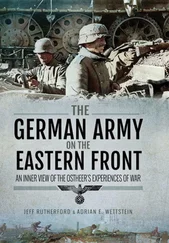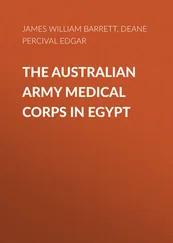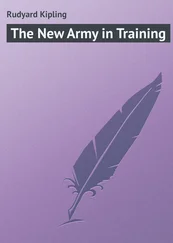(1) The tower operator commands:
TABLE SIX, NIGHT FIRE, CROUCHING POSITION, SEVEN ROUNDS.
LOAD AND LOCK ONE MAGAZINE.
IS THE FIRING LINE READY? (Firers using 9-mm pistols place them on double-action. )
READY ON THE RIGHT.
READY ON THE LEFT.
THE FIRING LINE IS READY.
FIRERS, UNLOCK YOUR WEAPONS.
FIRERS, WATCH YOUR LANES.
(2) At the end of the prescribed firing time, the tower operator commands:
CEASE FIRE.
ARE THERE ANY ALIBIS? (Alibis get 8 seconds for each round not fired. )
UNLOAD AND CLEAR ALL WEAPONS.
IS THE FIRING LINE CLEAR?
READY ON THE RIGHT.
READY ON THE LEFT.
THE FIRING LINE IS NOW CLEAR.
FIRERS, PLACE YOUR WEAPONS ON THE STANDS WITH SLIDES LOCKED TO THE REAR.
FIRERS AND SCORERS, MOVE DOWNRANGE AND CHECK YOUR TARGETS.
MARK AND COVER ALL HOLES.
B-3. Alibis
The scorer reports and records any weapon or target malfunction that occurs during fire. The firer is allowed one alibi at the end of each table. For Tables I through IV, he is allowed 8 seconds for each alibi. For Tables V and VI, he is allowed 10 seconds each. All alibis are fired where the malfunction occurred, and the same firing commands are used.
B-4. Scorecard
Figure B-1 shows a 25–meter E-type silhouette. Figure B-2 shows an example completed DA Form 5704-R ( Alternate Pistol Qualification Course Scorecard ). A blank copy is provided in the back of the book. The blank form may be reproduced locally on 8 ½- by 11-inch paper. It may also be downloaded from the Internet at Army Knowledge Online ( http://www.army.mil/usapa/eforms/).
a. Firing Tables I thru IV. Each time a firer hits or kills a target, the scorer places an “X” (for a hit) or “M” (for a miss) in the appropriate box, then writes the number of each in the “Hits” and “Misses” columns to the right. After the firer completes the first four firing tables, the scorer tallies the total hits and misses and uses the scoring grid to determine if the firer qualified on those four tables.
• EXPERT: 36 to 40 hits.
• SHARPSHOOTER: 30 to 35 hits.
• MARKSMAN: 24 to 29 hits.
• UNQUALIFIED: 0 to 23 hits.
b. Firing Tables V and VI. Each time a firer hits or kills a target, the scorer places an “X” (hit) or “M” (miss) in the appropriate box. Then, he writes the total number of hits and misses in the columns to the right. The firer must hit four targets in each table in order to receive a “GO” on that table.
B-5. Assistance
During instructional fire, the coach and assistant instructors should help the firer correct errors. However, during record fire, no one may help or try to help the firer while or after he takes his position at the firing point.
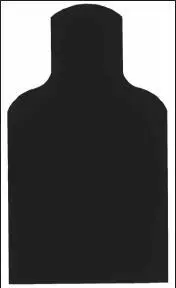
Figure B-1. E-type silhouette, 25-meter, without rings.

Figure B-2. Example completed DA Form 5704-R.
APPENDIX C
TRAINING SCHEDULES
To aid in the individual training phase, training schedules for the courses in pistol marksmanship training are described in this appendix. These schedules are based on the desirable number of training hours for a pistol course. They should be used as a guide in preparing lesson plans; conditions may require a longer or shorter period to complete the training. When time is available, additional training should be included in the schedule. When suggested equipment and training aids are not available, the best that are available should be improvised or substituted. Each firer should be allowed 50 rounds for instructional firing and 40 rounds for record firing.
C-1. 9-MM SEMIAUTOMATIC PISTOL, PRACTICE OR INSTRUCTIONAL FIRING COURSE (12 HOURS)
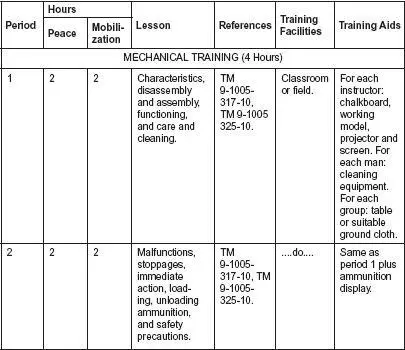
C-1. 9-MM SEMIAUTOMATIC PISTOL, PRACTICE OR INSTRUCTIONAL FIRING COURSE (12 HOURS) —(Continued )

C-2. 9-MM SEMIAUTOMATIC PISTOL, QUALIFICATION COURSE (12 HOURS)
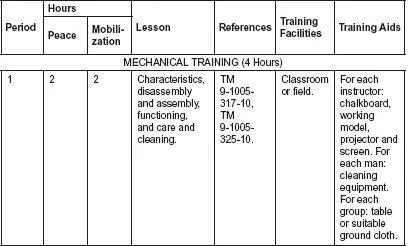

C-2. 9-MM SEMIAUTOMATIC PISTOL, QUALIFICATION COURSE (12 HOURS) —(Continued )

APQC — alternate pistol qualification course
AR — Army regulation
CBRN — chemical, biological, radiological, or nuclear
CLP — cleaner, lubricant, preservative
CPQC — combat pistol qualification course
CTA — common table of allowances
DA — Department of the Army
EENT — end evening nautical twilight
EMNT — end morning nautical twilight
FM — field manual
HQ — headquarters
LSA — lubricating [oil], semifluid, automatic [weapons]
MM — millimeter
MOPP — mission-oriented protective posture
NATO — North Atlantic Treaty Organization
NCOIC — noncommissioned officer in charge
NG — [Army] National Guard
OIC — officer in charge
QTTD — quickfire target-training device
RBC — rifle bore cleaner
RH — right hand
TM — technical manual
TRADOC — [US Army] Training and Doctrine Command
USAR — US Army reserve
DOCUMENTS NEEDED
These documents must be available to the intended users of this publication.
AR 385-63 — Policies and Procedures for Firing Ammunition for training, target Practice, and Combat. 15 October 1983.
DA Form 88 — Combat Pistol Qualification Course Scorecard.
DA Form 5704-R — Alternate Pistol Qualification Course.
TM 9-1005-317-10 — Operator's Manual for Pistol, Semiautomatic, 9-mm, M9 (1005-01-118-2640). 31 July 1985.
TM 9-1005-325-10 — Operator's Manual for Pistol, Compact, 9-mm, M11 (1005-01-336-8265) and Pistol, Compact, 9-mm, M11 with tritium Sights (1005-01-3400096). 16 December 1993.
TM 9-1300-200 — Ammunition, General. 3 October 1969.
SOURCES USED
These are the sources quoted or paraphrased in this publication.
AR 140-1 — Mission, Organization, and Training. 1 September 1994.
CTA 8-100 — Army Medical Department Expendable/Durable Items. 31 August 1994.
CTA 50-970 — Expendable/Durable Items (except: Medical, Class V repair Parts and Heraldic Items). 21 September 1990.
DA Pam 350-38 — Standards in Weapons Training. 3 July 1997.
DA Pam 738-750 — Functional Users' Manual for the Army Maintenance Management System (TAMMS). 1 August 1994.
FM 3-4 — NBC Protection. 29 May 1992, with Changes 1-2, 28 October 1992-21 February 1996.
Читать дальше
